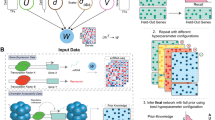ABSTRACT
Purpose
The area under the curve (AUC) is commonly used to assess the extent of exposure of a drug. The same concept can be applied to generally assess pharmacodynamic responses and the deviation of a signal from its baseline value. When the initial condition for the response of interest is not zero, there is uncertainty in the true value of the baseline measurement. This necessitates the consideration of the AUC relative to baseline to account for this inherent uncertainty and variability in baseline measurements.
Methods
An algorithm to calculate the AUC with respect to a variable baseline is developed by comparing the AUC of the response curve with the AUC of the baseline while taking into account uncertainty in both measurements. Furthermore, positive and negative components of AUC (above and below baseline) are calculated separately to allow for the identification of biphasic responses.
Results
This algorithm is applied to gene expression data to illustrate its ability to capture transcriptional responses to a drug that deviate from baseline and to synthetic data to quantitatively test its performance.
Conclusions
The variable nature of the baseline is an important aspect to consider when calculating the AUC.





Similar content being viewed by others
REFERENCES
Kwon Y. Handbook of essential pharmacokinetics, pharmacodynamics, and drug metabolism for industrial scientists. New York: Kluwer Academic/Plemun Publishers; 2001.
Krzyzanski W, Jusko WJ. Integrated functions for four basic models of indirect pharmacodynamic response. J Pharm Sci. 1998;87(1):67–72.
Tusher VG, Tibshirani R, Chu G. Significance analysis of microarrays applied to the ionizing radiation response. Proc Natl Acad Sci USA. 2001;98(9):5116–21.
Ernst J, Bar-Joseph Z. STEM: a tool for the analysis of short time series gene expression data. BMC Bioinform. 2006;7:191.
Jin JY, Almon RR, DuBois DC, Jusko WJ. Modeling of corticosteroid pharmacogenomics in rat liver using gene microarrays. J Pharmacol Exp Ther. 2003;307(1):93–109.
Wolfsegger MJ. Establishing bioequivalence in serial sacrifice designs. J Pharmacokinet Pharmacodyn. 2007;34(1):103–13.
Bonate PL. Coverage and precision of confidence intervals for area under the curve using parametric and non-parametric methods in a toxicokinetic experimental design. Pharm Res. 1998;15(3):405–10.
Mager H, Goller G. Resampling methods in sparse sampling situations in preclinical pharmacokinetic studies. J Pharm Sci. 1998;87(3):372–8.
Bailer AJ. Testing for the equality of area under the curves when using destructive measurement techniques. J Pharmacokinet Biopharm. 1988;16(3):303–9.
Yuan J. Estimation of variance for AUC in animal studies. J Pharm Sci. 1993;82(7):761–3.
Sharma A, Ebling WF, Jusko WJ. Precursor-dependent indirect pharmacodynamic response model for tolerance and rebound phenomena. J Pharm Sci. 1998;87(12):1577–84.
Woo S, Pawaskar D, Jusko WJ. Methods of utilizing baseline values for indirect response models. J Pharmacokinet Pharmacodyn. 2009;36(5):381–405.
Barrett T, Troup DB, Wilhite SE, Ledoux P, Rudnev D, Evangelista C, et al. NCBI GEO: archive for high-throughput functional genomic data. Nucleic Acids Res. 2009 Jan;37(Database issue):D885–90.
Storey JD, Tibshirani R. Statistical methods for identifying differentially expressed genes in DNA microarrays. Methods Mol Biol. 2003;224:149–57.
Wolfsegger MJ, Jaki T. Estimation of AUC from 0 to infinity in serial sacrifice designs. J Pharmacokinet Pharmacodyn. 2005;32(5–6):757–66.
Jaki T, Wolfsegger MJ, Ploner M. Confidence intervals for ratios of AUCs in the case of serial sampling: a comparison of seven methods. Pharm Stat. 2009;8(1):12–24.
Leek JT, Monsen E, Dabney AR, Storey JD. EDGE: extraction and analysis of differential gene expression. Bioinformatics. 2006;22(4):507–8.
Krzyzanski W, Jusko WJ. Characterization of pharmacodynamic recession slopes for direct and indirect response models. J Pharmacokinet Biopharm. 1998;26(4):409–36.
ACKNOWLEDGMENTS
JDS and IPA acknowledge support from NIH Grant No. GM082974. RRA, DCD and WJJ acknowledge support from NIH Grants No. GM24211 and GM57980.
Author information
Authors and Affiliations
Corresponding author
Rights and permissions
About this article
Cite this article
Scheff, J.D., Almon, R.R., DuBois, D.C. et al. Assessment of Pharmacologic Area Under the Curve When Baselines are Variable. Pharm Res 28, 1081–1089 (2011). https://doi.org/10.1007/s11095-010-0363-8
Received:
Accepted:
Published:
Issue Date:
DOI: https://doi.org/10.1007/s11095-010-0363-8




